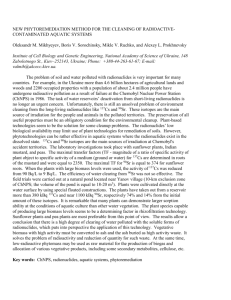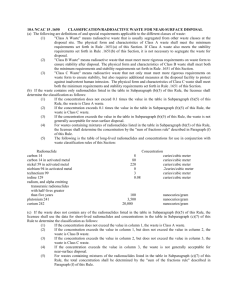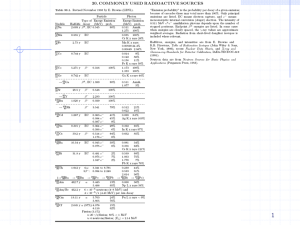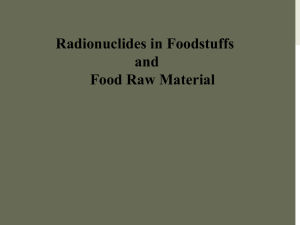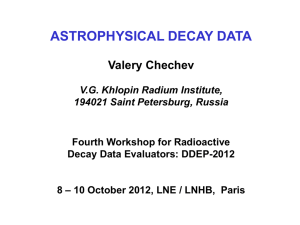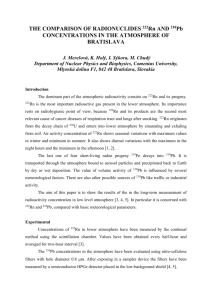effect enterosorbent enterosgel on the liver condition of
advertisement
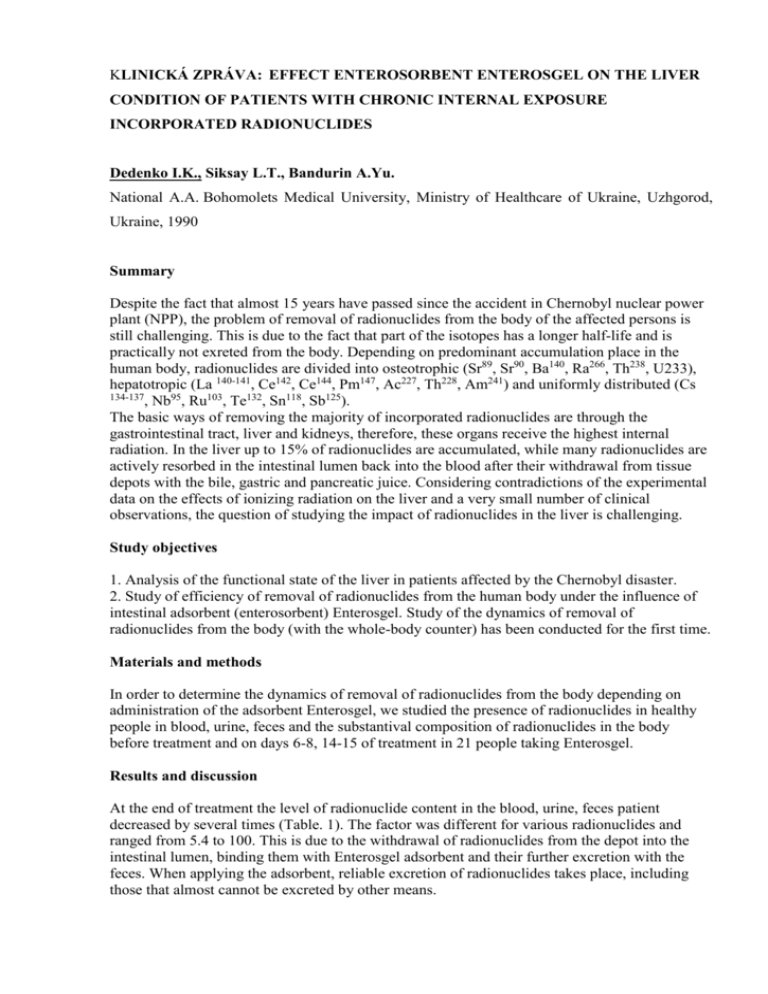
KLINICKÁ ZPRÁVA: EFFECT ENTEROSORBENT ENTEROSGEL ON THE LIVER CONDITION OF PATIENTS WITH CHRONIC INTERNAL EXPOSURE INCORPORATED RADIONUCLIDES Dedenko I.K., Siksay L.T., Bandurin A.Yu. National A.A. Bohomolets Medical University, Ministry of Healthcare of Ukraine, Uzhgorod, Ukraine, 1990 Summary Despite the fact that almost 15 years have passed since the accident in Chernobyl nuclear power plant (NPP), the problem of removal of radionuclides from the body of the affected persons is still challenging. This is due to the fact that part of the isotopes has a longer half-life and is practically not exreted from the body. Depending on predominant accumulation place in the human body, radionuclides are divided into osteotrophic (Sr89, Sr90, Ba140, Ra266, Th238, U233), hepatotropic (La 140-141, Ce142, Ce144, Pm147, Ac227, Th228, Am241) and uniformly distributed (Cs 134-137 , Nb95, Ru103, Te132, Sn118, Sb125). The basic ways of removing the majority of incorporated radionuclides are through the gastrointestinal tract, liver and kidneys, therefore, these organs receive the highest internal radiation. In the liver up to 15% of radionuclides are accumulated, while many radionuclides are actively resorbed in the intestinal lumen back into the blood after their withdrawal from tissue depots with the bile, gastric and pancreatic juice. Considering contradictions of the experimental data on the effects of ionizing radiation on the liver and a very small number of clinical observations, the question of studying the impact of radionuclides in the liver is challenging. Study objectives 1. Analysis of the functional state of the liver in patients affected by the Chernobyl disaster. 2. Study of efficiency of removal of radionuclides from the human body under the influence of intestinal adsorbent (enterosorbent) Enterosgel. Study of the dynamics of removal of radionuclides from the body (with the whole-body counter) has been conducted for the first time. Materials and methods In order to determine the dynamics of removal of radionuclides from the body depending on administration of the adsorbent Enterosgel, we studied the presence of radionuclides in healthy people in blood, urine, feces and the substantival composition of radionuclides in the body before treatment and on days 6-8, 14-15 of treatment in 21 people taking Enterosgel. Results and discussion At the end of treatment the level of radionuclide content in the blood, urine, feces patient decreased by several times (Table. 1). The factor was different for various radionuclides and ranged from 5.4 to 100. This is due to the withdrawal of radionuclides from the depot into the intestinal lumen, binding them with Enterosgel adsorbent and their further excretion with the feces. When applying the adsorbent, reliable excretion of radionuclides takes place, including those that almost cannot be excreted by other means. Study of excretion of Cs134-137 in patients with chronic hepatitis showed that the level of radioactive cesium in the patients taking Enterosgel decreased by 7.4 times and only by 2.3 times in those who did not take Enterosgel. Thus, taking Enterosgel both by healthy patients and by patients with chronic hepatitis caused by work in the contaminated zone, helps to accelerate the removal of radionuclides from the body. In order to determine the efficiency of the repeated courses of sorbent treatment in patients with chronic hepatitis, the dynamics of Ce144 levels was analyzed in the bile, gastric juice and feces. All study participants received three courses of 10-day cycles, with 10-day intervals. We have carried out recalculations of the daily amount of Ce144 excreted into the GIT lumen with bile, feces and gastric juice. Calculations showed that 1.07% of the total number of radionuclides per day is excreted in the GIT lumen with the feces, bile and gastric juice, indicating their resorption in the intestinal lumen. The calculations are an indirect confirmation of the need for intestinal sorption of radionuclides using adsorbents to reduce their resorption in the intestinal lumen. Table 1 Dynamics of blood, urine, feces radionuclides (nCi) in persons taking enterosorbent Enterosgel during the treatment (M ± m, n = 21) Radionu clides К40 Cs137 Ba140 La140 Sr125 Ru105 Ce144 Ce141 Blood Urine Feces Entry Days Days Entry Days Days Entry Days Days level 6-8 14-15 level 6-8 14-15 level 6-8 14-15 10,14 31,45 1,15 1,22 9,65 0,54 1,47 8,55 0,61 0,49 1,37 0,05 0,05 0,42 0,09 0,07 0,37 0,02 5,99 9,65 1,07 0,60 3,65 0,50 2,51 9,16 1,33 0,29 0,42 0,02 0,02 12,03 51,22 0,51 1,76 9,65 0,12 1,53 9,22 0,31 0,58 2,23 0,02 16,04 48,55 0,61 1,98 10,14 ,77 0,12 0,02 0,08 0,09 0,15 0,46 0,44 0,07 0,04 0,12 0,07 0,40 0,40 0,05 0,01 0,11 2,33 7,55 0,45 0,03 0,11 0,32 0,01 1,78 3,55 0.67 0,31 2,06 0,11 1,02 4,11 0,19 0,08 0,15 0.02 0,01 0,08 0,03 0,04 0,17 0,01 4,55 8,77 1,04 0,65 3,57 0,36 1,55 6,34 1,02 0,22 0,38 0,22 0,03 0,15 0,07 0,07 0,27 0,04 3,87 7,55 1,04 0,55 3,68 0,37 1,67 6,55 1,04 0,18 0,32 0,41 0,02 0,16 0,06 0,08 0,28 0,04 2,97 6,55 0.98 0,60 4,11 0,41 1,44 7,15 0,97 0,14 0,28 0.04 0,02 0,17 0,08 0,06 0,31 0,04 Cs134 4,91 8,66 1,55 0,51 3,18 0,41 2,04 8,34 1,55 0,23 0,37 0,06 0,02 0,13 0.05 0,09 0,36 0,06 Thus, as can be seen from the table, in chronic administration of radionuclides the most pronounced effect is provided by the repeated courses adsorbent Enterosgel. We have also examined the degree of accumulation of radionuclides depending on the nature of work in the contamination area. We have shown that reduction of radionuclides in patients who had worked in the Chernobyl exclusion zone after taking Enterosgel enterosorbent can be explained by the effect of sorption therapy. Analysis of the data indicates that radionuclides Ra226, Ba133, Bi210, Ac228 play a certain role in the formation of internal dose of blood and body as a whole in liquidators. Considering constant blood circulation of the mentioned radionuclides, even at doses that do not exceed the allowed maximum, the body constantly receives internal radiation, which can lead to homeostasis disorders To prevent resorption of radionuclides and reduce their concentration, it is recommended to apply absorbents administered in the GIT lumen. Conclusion 1. After work in the exclusion zone, functional state disorder of the liver is developed in healthy people. 2. In patients with of chronic liver diseases, deterioration of liver function was revealed after work in the exclusion zone. 3. Application of adsorbent Enterosgel promoted intensive release of radionuclides from the body tissues and their excretion in the adsorbed form with feces, which justifies the use of sorbent in contamination. 4. Accelerated release of radionuclides was the result of a general detoxifying action of Enterosgel and process of their direct binding in the GIT lumen. 5. Enterosgel provides effective detoxification, direct and indirect decorporation of radionuclides and improves the functional state of the liver. 6. We have also proved that administration of Enterosgel at work in the radioactive contamination area can be seen as immunoprotective method with indirect mechanism of action. 7. Enterosgel shows hepatoprotective effect in healthy people and to a lesser extent - in patients with chronic liver disease. 8. In case of chronic administration of radionuclides, the most pronounced effect is achieved with the repeated courses of the adsorbent Enterosgel.
